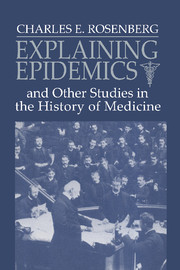Book contents
- Frontmatter
- Contents
- Acknowledgments
- Introduction: Why care about the history of medicine?
- I Ideas as actors
- 1 The therapeutic revolution: Medicine, meaning, and social change in nineteenth-century America
- 2 Medical text and social context: Explaining William Buchan's Domestic Medicine
- 3 John Gunn: Everyman's physician
- 4 Body and mind in nineteenth-century medicine: Some clinical origins of the neurosis construct
- 5 Florence Nightingale on contagion: The hospital as moral universe
- 6 Cholera in nineteenth-century Europe: A tool for social and economic analysis
- II Institutions and medical care
- III The past in the present: Using medical history
- Index
4 - Body and mind in nineteenth-century medicine: Some clinical origins of the neurosis construct
Published online by Cambridge University Press: 29 March 2010
- Frontmatter
- Contents
- Acknowledgments
- Introduction: Why care about the history of medicine?
- I Ideas as actors
- 1 The therapeutic revolution: Medicine, meaning, and social change in nineteenth-century America
- 2 Medical text and social context: Explaining William Buchan's Domestic Medicine
- 3 John Gunn: Everyman's physician
- 4 Body and mind in nineteenth-century medicine: Some clinical origins of the neurosis construct
- 5 Florence Nightingale on contagion: The hospital as moral universe
- 6 Cholera in nineteenth-century Europe: A tool for social and economic analysis
- II Institutions and medical care
- III The past in the present: Using medical history
- Index
Summary
Contemporary physicians often file the study of relations between body and mind under the rubric of psychosomatic medicine, a mid-twentiethcentury movement inspired by a self-conscious desire to counteract what its founders felt to be the profession's dominant mechanistic and reductionist tendencies. Yet interest in the relationship between body and mind is, of course, much older. Physicians have always assumed that emotional factors can induce sickness, undergird health, or – properly manipulated – bring about its restoration. The hypothetical mechanisms used to explain this interdependence have changed during the past few centuries, but the clinical reality they sought to explain has never been in doubt.
This essay was originally delivered as the Benjamin Rush Lecture to the American Psychiatric Association in 1988 – at a moment when the longtime domination of dynamic, intrapsychic models in psychiatry had waned, while somaticism had attained increasing prominence. I tried not only to suggest the antiquity of medical concern with the interaction of body and mind but also to underline a continuing and more general ambiguity. As we concern ourselves increasingly with individual lifestyle as a factor in the pathogenesis of chronic disease – in cancer and circulatory disease, for example, or alcoholism – we underline another aspect of mind: volition and thus responsibility. In that elusive and shadowy terrain between blaming and explaining, the relevance of body-and-mind relationships remains central, especially when we consider choice as well as stress.
- Type
- Chapter
- Information
- Explaining Epidemics , pp. 74 - 89Publisher: Cambridge University PressPrint publication year: 1992
- 3
- Cited by



